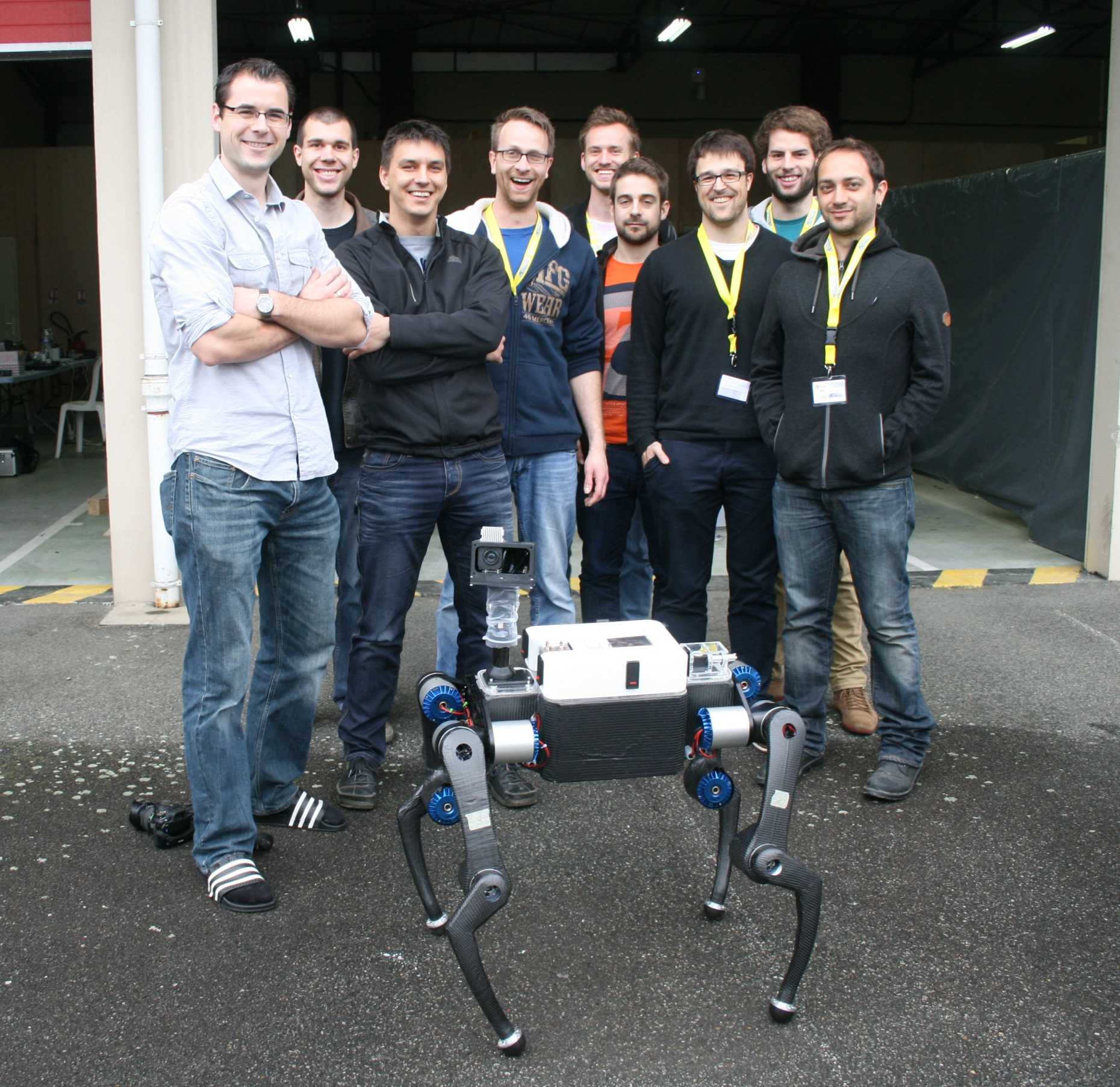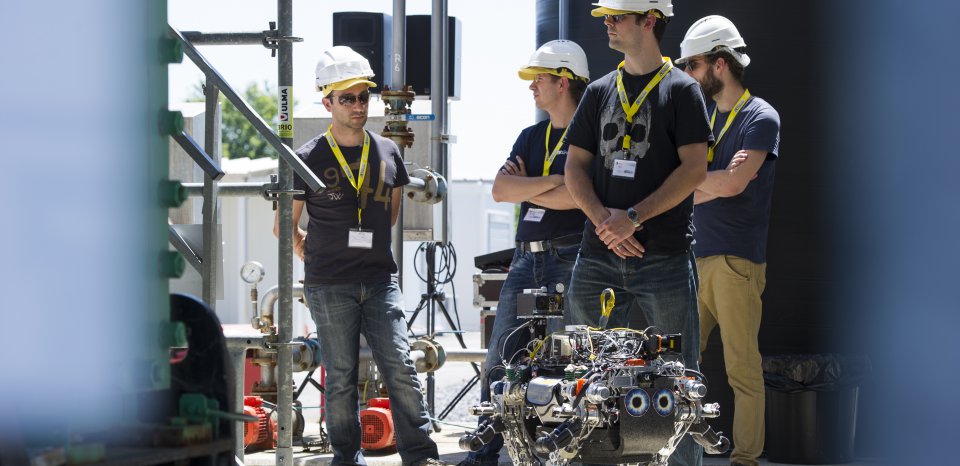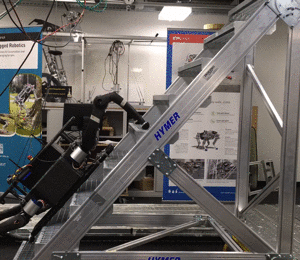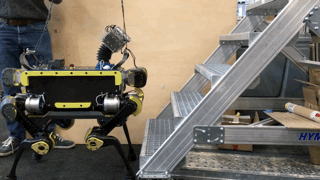ARGOS Challenge
Project Homepage: external page http://www.argos-challenge.com
Short description
Since June 2014, we are participating at the ARGOS Challenge (ARGOS = Autonomous Robot for Gas and Oil Sites). The challenge seeks for a robust robot with a high level of autonomy (in terms of motion control/execution, path planning, and perception) for the inspection of petrochemical facilities.
Not so short description
Intro:
5 out of 31 international candidates from 15 different countries have been selected for the participation at the ARGOS challenge. Along with teams from Japan, France, Spain, and Austria/Germany, our team represents Switzerland with StarlETH, the only walking robot in the challenge.
Background:
The challenge has been initiated by Total SA and is organized by ANR (Agence Nationale de la Recherche (ANR)). The purpose of the challenge is to boost the development of autonomous systems for the application for dull, dirty, and/or dangerous tasks on Totals facilities: \\
« Exploration and production in extreme conditions – severe cold in the Arctic, isolated offshore and onshore sites, acid gases, arid climates, etc. – are fundamental issues for the oil & gas industry. In the future, surface robotics, seldom used as yet in our activities, should enable us to rise to these new challenges and at the same time reduce our personnel’s exposure to risk.” , Daniel Plathey, Total, Vice President R&D,
The Challenge:
The teams that participate will have two and half years to develop a robot that complies to the requirements of Total. The robots have to navigate in an multi-level, outdoor facility, examine checkpoints and detect, identify and report internal and external anomalies. The inspection includes reading & interpreting of dial indicators (such as pressure gauges), liquid level gauges, valve positions and detecting missing safety equipment, removed plugs of pipes or even gas leakages. The robots have to be able to climb over obstacles and move on slopes or stairs to reach the checkpoints.
Therefore, the robot will be equipped with various cameras (visual spectrum, thermal) and range finders (RGB-D camera, 3D LiDAR) (for the second competition possibly even an acoustic camera of Distran).
Our approach:
In contrast to our four competitors that deploy robots with tracks, we are competing with a legged platform based on StarlETH. We see the main advantages in the mobility that is enhanced by the possibility to move in all directions (omnidirectional), to move over obstacles without touching them, and the possibility to actively shift the center of mass to influence the stability.
The drawbacks are the complexity to design a robust walking robot in terms of hard- and software and to control such a system with many degrees of freedom.
Links:
external page Official Webpage
external page Facebook page of the teams
News / Update Reports Team LIO
Dec 2014
Since selected to participate, we have been enhancing the capabilities of our legged robot StarlETH towards the demanding requirements of the ARGOS Challenge. Besides mobility related improvements, we have been working on anomaly detection and reporting. In this context, we extended the sensor equipment with a pan-tilt unit that consists of a thermal and a visual zoom camera for inspection and microphones to detect acoustic alarms. To process the novel sensor data and to control all the devices for the inspection, a dedicated computer was added. We started working on the algorithms, e.g. to automatically detect and read pressure gauges, and on the human-machine interface for operation. Further, we revised our existing software architecture to simplify the development, maintenance and application and to increase the reliability. With respect to management, the organizational structure was defined and regular meetings have been held, including weekly experimental sessions with the robot. Despite the actual progress, we are expecting many challenges caused by the high level of realism of the contest. We are looking forward to the training sessions in April that will help to identify weaknesses of our approach and we are eager to deploy our legged robot at the first competition in Summer 2015.
April 2015
Team LIO can look back to a very interesting, intense, well-organized and instructive training week. Although the teams are in direct competition during the ARGOS challenge, we experienced a very friendly atmosphere and enjoyed great know-how exchange that helps all participants to achieve their best. For the first time, team LIO could successfully test some autonomous inspection missions on the ARGOS site. Our approaches for localization as well as for manometer inspection worked reliably. The same holds for the developed user interface: wide-angle cameras placed around the robot provide a comfortable overview for the operator for navigation, while a single zoom camera can be used on demand to get a detailed view of selected areas. Until the first challenge in June, there is still a lot to do. So far, all our tests have been conducted with our research quadrupedal robot StarlETH. While the robot provides the same functionality as its successor, it will not be able to meet the IP and ATEX requirements. Hence, our team is working hard to complete ANYmal, the robot for the first challenge. Unfortunately, the training week has also shown that our network devices are not well compatible with the installation on the training site. Since it is impossible to reproduce the same setup at ETH, this will remain a critical element until the first competition. Nonetheless, we are convinced to master the last challenges and are looking forward to meet the other teams and the Total crew again in summer!


August 2015: First challenge is over
Due to hardware issues with ANYmal, team LIO had to send StarlETH into the first competition. Despite expected reliability issues, we could complete an entire autonomous missions and showed the best inspection performance of all teams.
September 2015: Lessons learned from the first challenge
Being the only team to have accepted the challenge with a legged robot, the competition has so far generated a great deal of practical insights and technical progress for us. We believe that we have prepared well for the first round, but we almost instantly had to face the mechanical and electronic complexity of our platform when deployed in a highly realistic scenario rather than under laboratory conditions. We have thus experienced that platform robustness and safety is a key objective in the challenge which can easily outweigh a high level of agility and autonomy. We have further learned that a walking platform can be much harder to remote-control than a wheeled system due to the lateral motion of its base body. This may incite the human operator to induce corrective control inputs and thus inflict undesired motion behavior. Despite our motivation to improve on these aspects, our positive results in fulfilling the task requirements and in autonomously completing complex missions has inspired us to focus on the mission design and feedback tools. Thus, we intend to vastly simplify the handling of our system for non-expert operators and to raise its attractiveness as a potential ready-to-market inspection robot.

February 2016: Preparation for C2
Our Team LIO has had a couple of exciting breakthroughs in the last couple of months in the preparation for the 2nd ARGOS Challenge.
We are happy to report that we were able to verify that our quadrupedal robot design is suited to climb up and down the steep stairs of the training site. Although it would be possible to negotiate the steps by stepping with the feet, we decided to use a turtle-like motion to reduce the risk for the robot to fall or tip over. Using hooks on the lower side of the base allows our robot ANYmal to quickly and safely negotiate the stairs.
In other work, we improved our user interface to control the robot and monitor the mission’s progress. All elements, such as 3d view, mission protocols, and sensor and actuator statuses etc. are displayed in a single window providing an overview and fast access to most user actions. Whenever user interaction is required (such as in case of unknown obstacles), the user is prompted with an unintrusive notification together with suggestions for possible choices and the associated probabilities for success.
Finally, we have extended the localization capabilities to allow the robot to find its position when blindly dropped in an unknown area (kid-napping scenario). We deploy an extensive search algorithm to find matching plane triplets extracted from the scanned point clouds and the reference map.
Although we have made important progress in terms of both hard- and software for the 2nd ARGOS challenge, we hold big respect for the real tasks and unforeseen challenges that will arise during the competition. Here, we hope to reach the necessary robustness and reliability with our complex inspection machine and that we will be able to leverage the versatility and adaptability of our legged robot ANYmal to succeed. We are all very excited about the next challenge and are looking forward to showcase all our efforts.
July 2016
In the second competition, team LIO could use for the first time the new legged platform ANYmal. The machine showed great capabilities as it was able to perform all kinds of maneuvers during the missions, resulting in the second best performance. Thanks to large join mobility, the only 30kg heavy ANYmal is able to climb stairs, get across obstacles without touching them, and can change body height and orientation for inspection. For the upcoming challenge, the main focus is put on reliability of the robot. This starts with major improvement of the software and onboard electronics to avoid any failure of the system. As soon as the last inspection tasks are clarified, we will also complete the integration of the sensor head as well as the docking station for charging. Finally, and most importantly, to prevent mechanical damage even in case of falling, ANYmal will be additionally equipped with a roll-over protection cage. The goal for the last challenge is to finally convince TOTAL about the great potential of legged systems and their appropriateness for the inspection scenario. Besides completing the tasks on regular missions, we want to demonstrate generic solutions to improve autonomy and versatility of our robot and to make it ready for deployment on any other oil and gas site.

February 2017: update before C3
Over the last year, team LIO has completely revised and improved their robot ANYmal. The new machine is much more robust and ATEX certifiable. It additionally features larger mobility, longer endurance, more sensors, and new onboard electronics. This walking robot is able to traverse even larger obstacles making it applicable to all kind of challenging environments. Moreover, a docking station was built for autonomous charging of the battery and to pressurize the main body with Nitrogen.
On software level, the team further extended the established infrastructure. The already advanced localization, mapping and navigation tools were further improved to resolve some of the encountered problems during C2. Moreover, new tools based on deep learning algorithms are used for obstacle and people detection.
The team is working day and night to get ready for the finals! They are looking forward to show the great potential of legged systems compared to conventional solution.